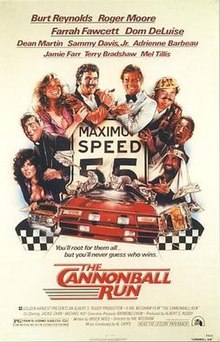
Burton Leon Reynolds Jr. was an American actor and considered a sex symbol and icon of 1970s American popular culture. Reynolds first rose to prominence when he starred in television series such as Gunsmoke (1962–1965), Hawk (1966), and Dan August (1970–1971). He had leading roles in films such as Navajo Joe (1966) and 100 Rifles (1969), and his breakthrough role was as Lewis Medlock in Deliverance (1972).

A stunt is an unusual, difficult, dramatic physical feat that may require a special skill, performed for artistic purposes usually for a public audience, as on television or in theaters or cinema. Stunts are a feature of many action films. Before computer-generated imagery special effects, these depictions were limited to the use of models, false perspective and other in-camera effects, unless the creator could find someone willing to carry them out, even such dangerous acts as jumping from car to car in motion or hanging from the edge of a skyscraper: the stunt performer or stunt double.

A stunt performer, often called a stuntman or stuntwoman and occasionally stuntperson or stunt-person, is a trained professional who performs daring acts, often as a career. Stunt performers usually appear in films or on television, as opposed to a daredevil, who performs for a live audience. When they take the place of another actor, they are known as stunt doubles.

Daniel Sexton Gurney was an American racing driver, race car constructor, and team owner who reached racing's highest levels starting in 1958. Gurney won races in the Formula One, Indy Car, NASCAR, Can-Am, and Trans-Am Series. Gurney is the first of three drivers to have won races in sports cars (1958), Formula One (1962), NASCAR (1963), and Indy cars (1967), the other two being Mario Andretti and Juan Pablo Montoya.
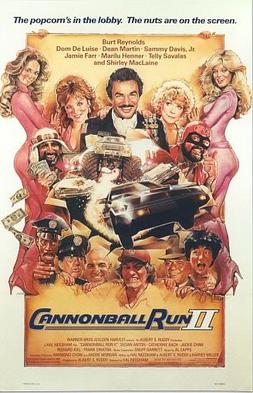
Cannonball Run II is a 1984 American action comedy film starring Burt Reynolds and an all-star cast, released by Warner Bros. and Golden Harvest. Like the original Cannonball Run, it is set around an illegal cross-country race.
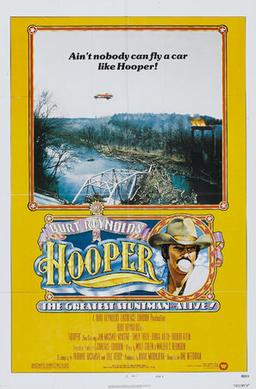
Hooper is a 1978 American action comedy film directed by Hal Needham and starring Burt Reynolds, Sally Field, Jan-Michael Vincent, Brian Keith, Robert Klein, James Best and Adam West. The film serves as a tribute to stuntmen and stuntwomen in what was at one time an underrecognized profession. At the time of filming, Field and Reynolds were in a relationship, having met on the set of Smokey and the Bandit the previous year.
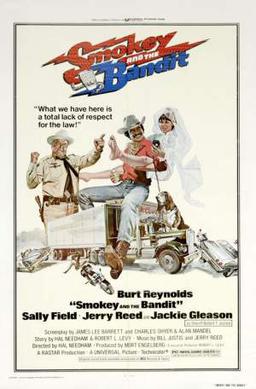
Smokey and the Bandit is a 1977 American action comedy film starring Burt Reynolds, Sally Field, Jackie Gleason, Jerry Reed, Pat McCormick, Paul Williams and Mike Henry. The film marks the directorial debut of stuntman Hal Needham.

Car and Driver is an American automotive enthusiast magazine first published in 1955. In 2006 its total circulation was 1.23 million. It is owned by Hearst Magazines, who purchased it from its prior owner Hachette Filipacchi Media U.S. in 2011. It was founded as Sports Cars Illustrated. The magazine is based in Ann Arbor, Michigan.

Hal Brett Needham was an American stuntman, film director, actor, writer, and NASCAR team owner. He is best known for his frequent collaborations with actor Burt Reynolds, usually in films involving fast cars, such as Smokey and the Bandit (1977), Hooper (1978), The Cannonball Run (1981) and Stroker Ace (1983).
Brock Yates was a prominent American journalist, TV commentator, TV reporter, screenwriter, and author. He was the longtime executive editor at Car and Driver magazine — and contributed to The Washington Post, Playboy, The American Spectator, Boating, Vintage Motorsports as well as other publications.
An outtake is a portion of a work that is removed in the editing process and not included in the work's final, publicly released version. In the digital era, significant outtakes have been appended to CD and DVD reissues of many albums and films as bonus tracks or features, in film often, but not always, for the sake of humor. In terms of photos, an outtake may also mean the ones which are not released in the original set of photos.

Smokey and the Bandit II is a 1980 American action comedy film directed by Hal Needham, and starring Burt Reynolds, Jackie Gleason, Jerry Reed, Dom DeLuise, Sally Field, Mike Henry, Paul Williams and Pat McCormick. The film is the second installment of the Smokey and the Bandit trilogy in the Smokey and the Bandit franchise and a sequel to Smokey and the Bandit (1977).

Megaforce is a 1982 action film directed by former stuntman Hal Needham and written by James Whittaker, Albert S. Ruddy, Hal Needham and André Morgan based on a story by Robert S. Kachler. The film starred Barry Bostwick, Persis Khambatta, Michael Beck, Edward Mulhare, George Furth, Evan C. Kim, Ralph Wilcox, Robert Fuller and Henry Silva. The film was poorly received by critics, bombed at the box office and was nominated for three Golden Raspberry Awards, including Worst Picture.

Cannonball is a 1976 American comedy film directed by Paul Bartel and starring David Carradine. The film is one of two released in 1976 that were based on a real illegal cross-continent road race that took place for a number of years in the United States. The same topic later became the basis for the films The Cannonball Run, Cannonball Run II and Speed Zone. The film was written and directed by Paul Bartel, who also directed Death Race 2000.

The Gumball Rally is a 1976 American action comedy film, directed and co-written by Charles Bail, a former stunt coordinator also known as Chuck Bail, about an illicit coast-to-coast road race. It was inspired by the Cannonball Baker Sea-to-Shining-Sea Memorial Trophy Dash run by Brock Yates, which inspired several other films, including Cannonball (1976), Cannonball Run (1981), and Speed Zone (1989), as well as an actual event, the American Gumball Rally and Gumball 3000 international race.
The Cannonball Baker Sea-to-Shining-Sea Memorial Trophy Dash, widely known as the Cannonball Baker or Cannonball Run, was an unofficial, unsanctioned automobile race run five times in the 1970s from New York City and Darien, Connecticut, on the East Coast of the United States to the Portofino Inn in the Los Angeles suburb of Redondo Beach, California. The Cannonball Run races have additionally inspired numerous contemporary efforts by independent teams to set the record time for the route, known as the Cannonball Run Challenge. The races were named after Erwin Baker.
Cannonball Run 2001: Race Across America or known simply as Cannonball Run 2001, is an American reality television series that was broadcast on the USA Network from August 5 to September 2, 2001. It was inspired by the Cannonball Baker Sea-to-Shining-Sea Memorial Trophy Dash, an outlaw road race of the 1970s which was the source for the famous 1981 film The Cannonball Run and its sequel, Cannonball Run II (1984). The show featured a series of five location-specific challenges along a New York-to-Los Angeles course, as in the original race.

Speed Zone is a 1989 American action comedy film set around an illegal cross-country race. The plot follows the race sponsors, who must line up new contestants after the previous racers are all arrested before the race begins.

The Lotus 38 was the first rear-engined car to win the Indianapolis 500, in 1965, driven by Jim Clark. It was run by Lotus at Indianapolis from 1965 to 1967; a total of 8 were built, most for use by Lotus, but several were sold for use by other drivers, including A. J. Foyt and Mario Andretti.
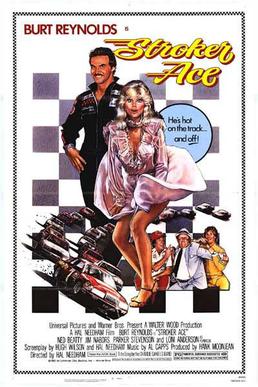
Stroker Ace is a 1983 American action comedy sport film directed by Hal Needham and starring Burt Reynolds as the eponymous Stroker Ace, a NASCAR driver.
